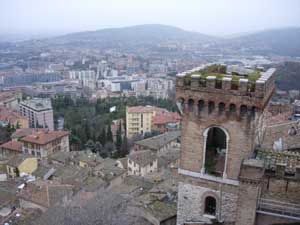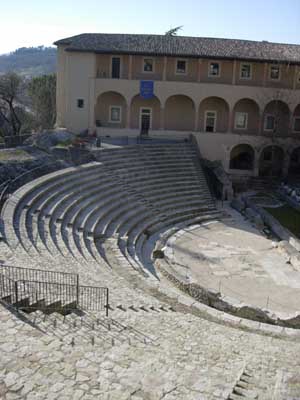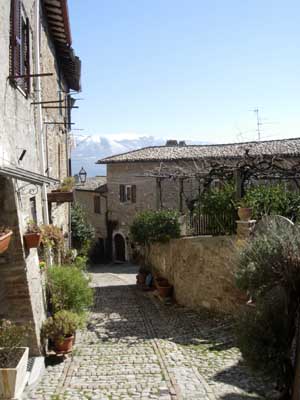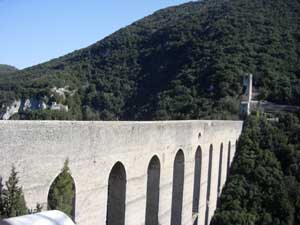|
volante:
italy

Like the food that inspired it, Umbria’s
food, villages and culture comprise a feast for the senses by
Elyse Glickman
photographed by the author
From
issue 20 of Lucire


UMBRIA is referred to as ‘the green heart of Italy,’ and it certainly
lives up to that motto with an expansive offering of historical
sites, earthy dishes and local delicacies that capture the region’s
mood and make for a journey that is, literally, a banquet for all
five senses. Each city, from the bustling centre of Perugia, to
the graceful Orvieto, to cultural and lively Spoleto, to the commanding
presence of Gubbio, is filling and hearty in its own right. Many
country inns and the smaller villages, meanwhile, represent a form
of la dolce vita that is at once civilized, familial and
very relaxed.
The most challenging aspect about a visit to Umbria
(as with most of Italy) is that there are so many gorgeous places
steeped in culture and history, accessible and inviting, that you
have to decide whether you want to see as much of this region as
you can in a week, or just pick a few spots to thoroughly savour.
That being said, our trip, which was painstakingly planned by the
Italian Government Tourist Board (and capably lead by Lia Pesce
from the New York office), was a brimming candy-box sampler of the
best things each city had to offer.
After our long flight in from the States, Lia
felt a visit around Perugia’s highlights, including Rocca Paolina,
Palazzo dei Priori, Fontana Maggiore and the Galleria Nazionale
dell’Umbria (which really deserves a full day’s visit), was the
ideal way to set the mood for a vibrant, exhaustive trip. However,
what really set the mood and took my breath away was my posh room
at the well-worth-the-euros Hotel Brufani Palace (Piazza Italia,
12, Perugia 06100), where the first thing that greeted me every
morning during my stay was a panoramic view of the city and surrounding
countryside as well as an excellent breakfast buffet. The staff
and service were also first-class, as was the subterranean pool
and workout area.
The next day, it was off to Assisi to see the
landmarks key in the life of St Francis of Assisi, and then, to
stroll through a charming village called Spello, where we experienced
an enchanting contemporary art gallery as well as view more antiquities.
By the time dinner rolled around, my jet lag was finally wearing
off, and I was at last truly awake to experience the region’s true
historic splendour.
A fine place to begin this sort of journey was
the Redibis Ristorante at Orto Degli Angeli (www.ortoangeli.it
or www.redibis.it, 06031 Bevagna),
just outside of Spello. The keystone of this landmark hotel–restaurant
property is a 2,000-year-old Roman theatre, with rooms and other
dwellings added through the centuries. Thanks to the careful planning
of its current owners, the experience is still quite theatrical,
with attentive service, contemporary furnishings and lighting that
add to the impact of being inside a piece of living history.
Although a late winter storm did not permit us
to enjoy the full splendour of the village of Todi (though we did
enjoy a warm, strong cup of cappuccino in the shadow that town’s
cathedral in their Piazza del Populo), the weather cleared up on
time for us to really enjoy Orvieto, one of the most romantic of
the mediæval towns, where it’s easy to get lost amid the city’s
winding streets, quaint dwellings, multiple wine bars and gorgeously
appointed shops. You could also get lost amid the sheer brilliance
of the famous Duomo cathedral and St Brizio’s Chapel with their
luminous windows, dazzling paintings and architecture. After getting
two hours to meander through Orvieto’s slender streets and enjoy
the vistas, we unwound at Il Maurizio, a warm and open space in
the shadow of the Duomo that offers simple but elegant takes on
central Italian fare utilizing local produce and artisinal products.
Anthropology buffs, meanwhile, should check out
Pozzo della Cava, a museum that brings the experience of an archæological
dig to life. If time allows you to go on to Roma, make an effort
to visit Narni, which dates back to Neolithic times and was known
as ‘Narnia’ in 299 BC when it became a Roman Municipality. The ‘Narni
Underground’ beneath the church of St Dominic, consists of an early
Roman church, with thirteenth- and fifteenth-century frescos, a
Roman cistern and a prison cell used by the tribunal of Inquisition,
where the graffiti prisoners scratched on the walls can be seen.
The richly rustic village of Citta della Pieve
is both home to several historical spots and galleries displaying
legendary artist Perugino’s master-pieces as well as the Hotel Vannuci
(Via l. Vanni 1—www.hotel-vannucci.com), a gorgeous nineteenth-century
country villa brought into the 21st century with contemporary furnishings,
imaginative lighting fixtures that resemble trees and vibrant art
glass accents. Like the hotel, the adjoining Zafferano restaurant
is a celebration of time-honoured regional spices—especially saffron,
which is the restaurant’s namesake. While most people associate
saffron with savoury foods, it is successfully used in the vanilla
semifreddo desert with chocolate, saffron sauce and Muscat gelatin.
Nevertheless, with pasta as a savoury dish of choice, our pick was
created by Chef Filippo Germasi, which used fresh local ingredients
to maximum effect. However, he assures us that the recipe can be
re-created anywhere—even if the scenery outside, alas, can only
be captured in photos.
Another converted landmark worth visiting, either
for a wine tasting (as we did it) or for an extended stay is La
Badia (Localita la Badia 8, 05019 Orvieto), a twelfth-century monastery
nestled in one of the greenest areas of Umbria. Even on a cloudy
day, I can guarantee your photos will be alive with colour and history.
If time allows, or if the locals showing you around insist (and
they probably will—they are fiercely proud of their region’s beauty)
you will venture to Castiglione del Lago, another spot nature and
history buffs will enjoy. Anybody with a home to decorate will ultimately
feel the urge to bring some representation of the famous Umbria
pottery home (I suggest taking extra bubble wrap with you if that
is part of your plans). One place to witness the evolution of one
of Umbria’s signature crafts is the town of Deruta, home of Laboratorio
di Ceramica ‘L’Antica Deruta’ Moretti. Though the shop mainly caters
to people in the interior design and retail trades, the museum side
of the shop (where nothing is for sale but everything is displayed
for all to enjoy) will no doubt confirm that Italian pottery is
here to stay.
If any place captures the grandeur and mediæval
splendour from a storybook perspective, it is the city of Gubbio,
thanks in part to its steep and narrow streets as well as an imposing
civic palace and an elevated city square that glows white and bright
against the backdrop of mountains, green fields and blue skies.
Bringing an extra dimension of warmth and flavour to this elegant
place is the warm, masculine Taverna del Lupo (Via G. Ansidei, 6,
Gubbio; 34 075-927-4368). Not surprisingly, the fare offered here
is strong and hearty, and characterized by strong flavours, aromas
and textures that render the dishes ideal comfort food for this
mountainous area.
While Il Pentagramma in Spoleto (one of Umbria’s
cultural hubs) has a warm, old world cucina feel to it, it
has kept with the times since 1959 with imaginative spins on local
dishes and decorative items that playfully and visually represent
the popular Spoleto Jazz Festival, which draws attendees from around
the world. On our trip, the Zuppa di Farro (a lovely soup of mixed
beans served in an edible bowl made from crisped pizza crust) was
a hands-down crowd-pleaser as was the simple but striking "priest
choker pasta" in a classic marinara sauce. Even if your trip
does not coincide with the Spoleto Jazz Festival, take the time
to wander the area anyway, especially with a trip across the Ponte
delle Torri and the Rocca Albornoziana. Not far from Spoleto is
Montefalco, a delightful village that is also a wine lover’s paradise,
especially given that the area is famous for Sagrantino, a highly
flavourful red wine mostly exclusive to this region. If you are
anxious to build up your knowledge of regional Italian viticulture,
a visit to the Conzorzio del Sagrantino is a must. (For more information
about Montefalco wines, or to arrange a visit to the region and
its wineries, please refer to www.stradedelsagrantino.it
or www.contorziomontefalco.it)
While Tuscan wine is familiar to most American
foodie palates, the Lungarotti sisters (Chiara Lungarotti and Teresa
Severini) are working very hard to change that with their emphasis
on producing quality reds and whites and bringing them wholeheartedly
into the US market. However, they are steadfastly not straying from
the culinary and hospitality traditions of Umbria. Further ingratiating
themselves as the toast of Torgiano (just outside the local capital
of Perugia), the sisters and their family are responsible for the
creation of olive oil and wine museums, olive oil production (including
a line for Williams–Sonoma) and the operation of three boutique
hotel properties (Le Tre Vaselle, Poggio alle Vigne and Il Pometo)
as well as the acclaimed restaurant Tre de Vaselle, (06089 Torgiano,
www.tre.vasele.it), which
is the ideal showcase for Napoli-bred executive chef Domenico d’Imperio
to wow diners with his exquisite and exquisitely simple creations.
•


Comments
|
Umbria to go
|

